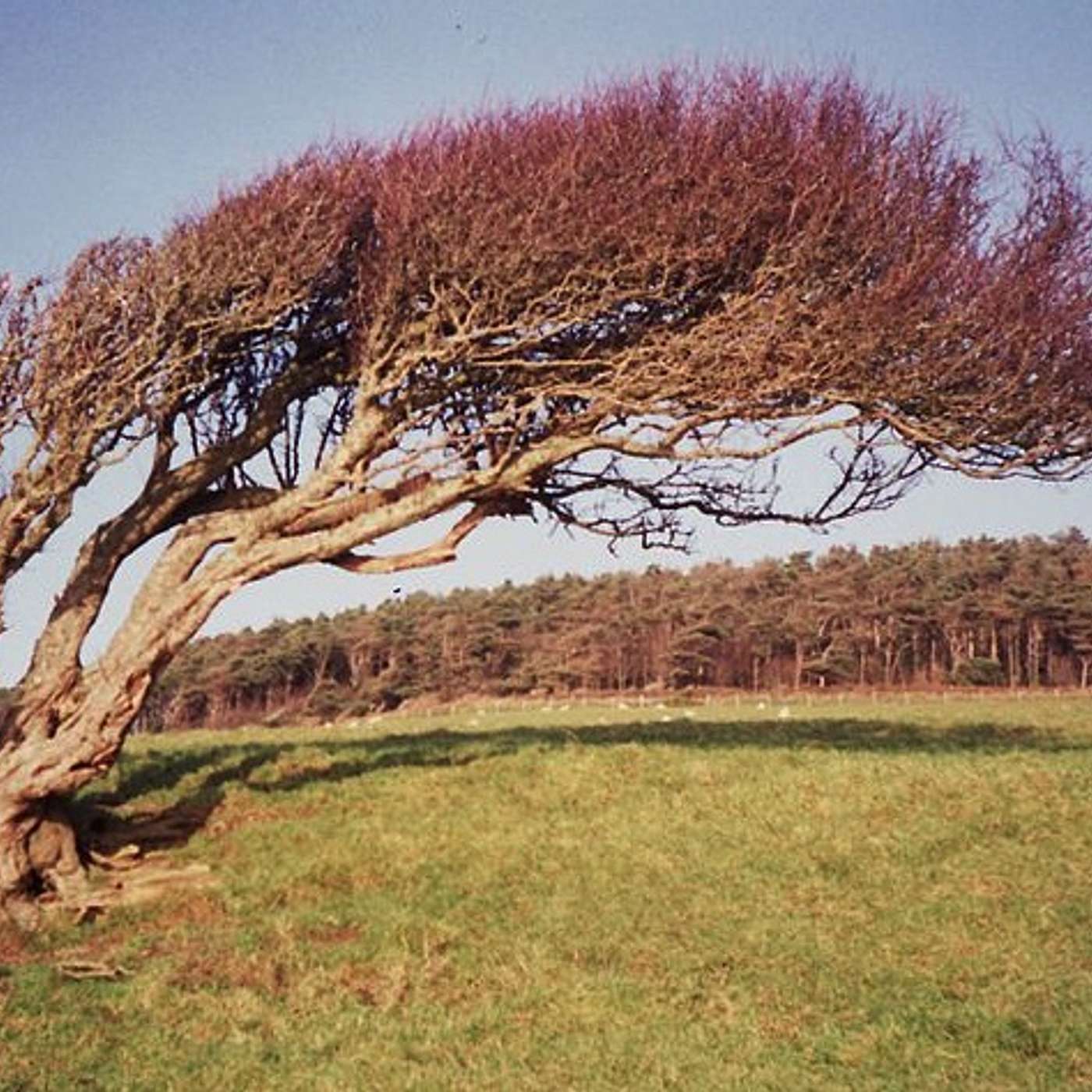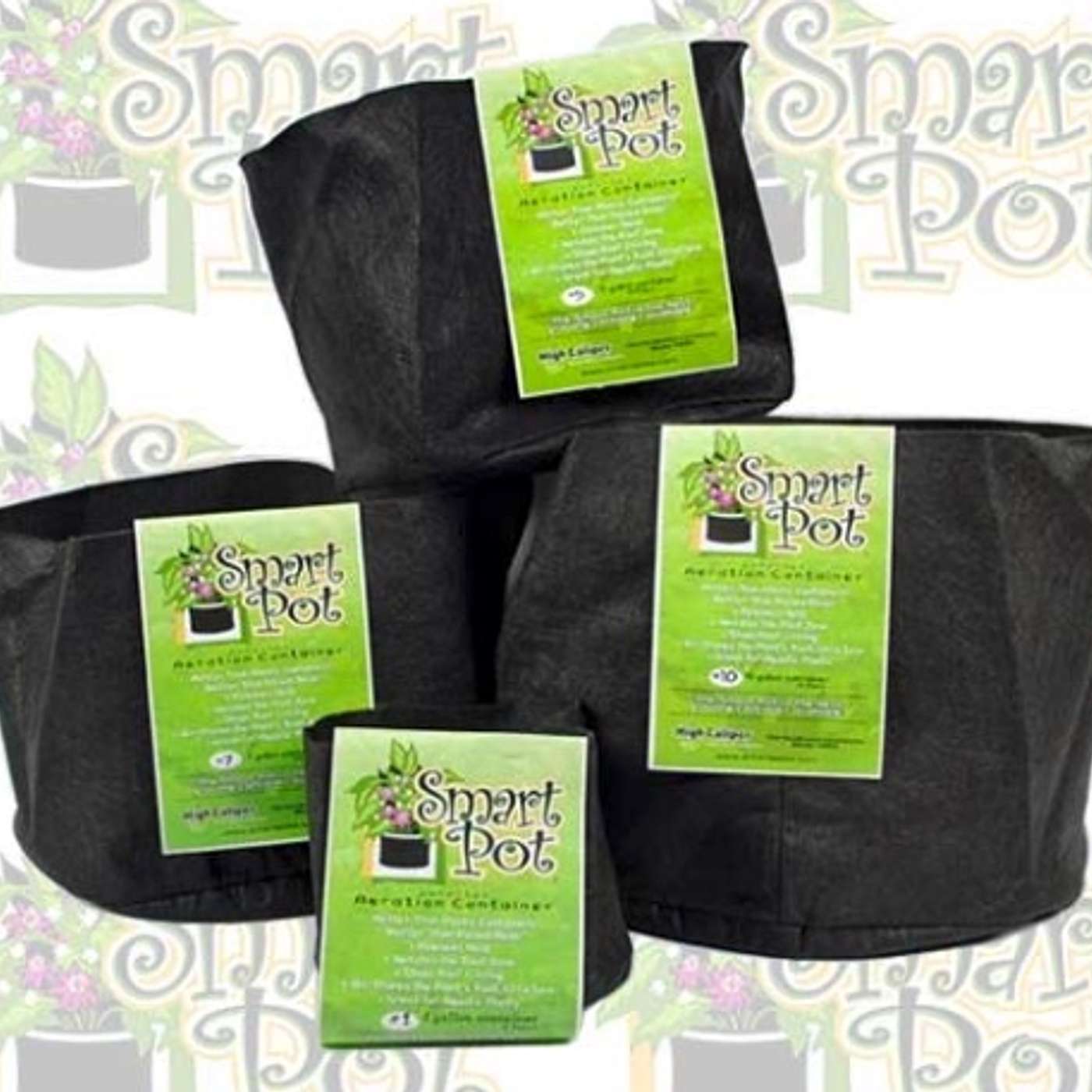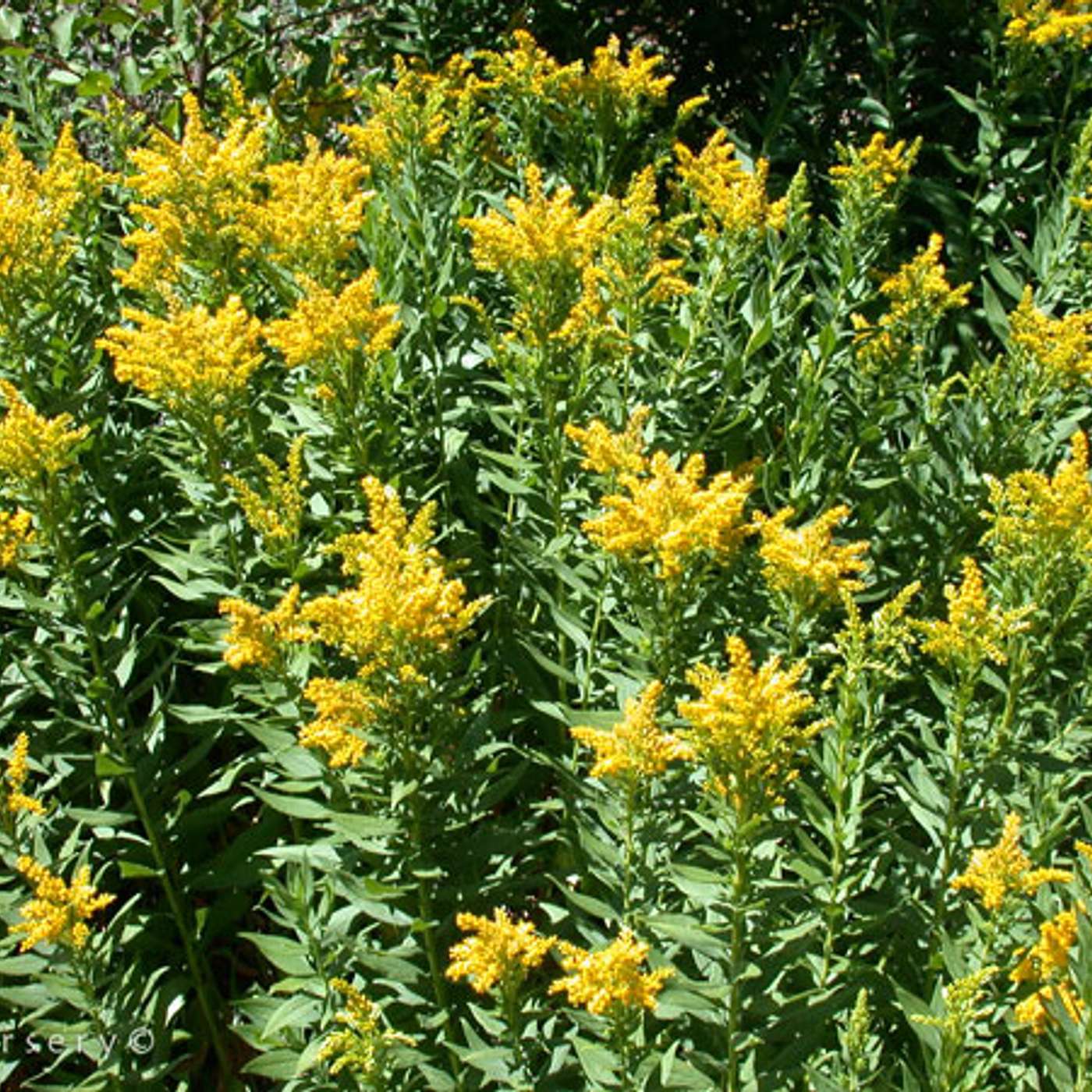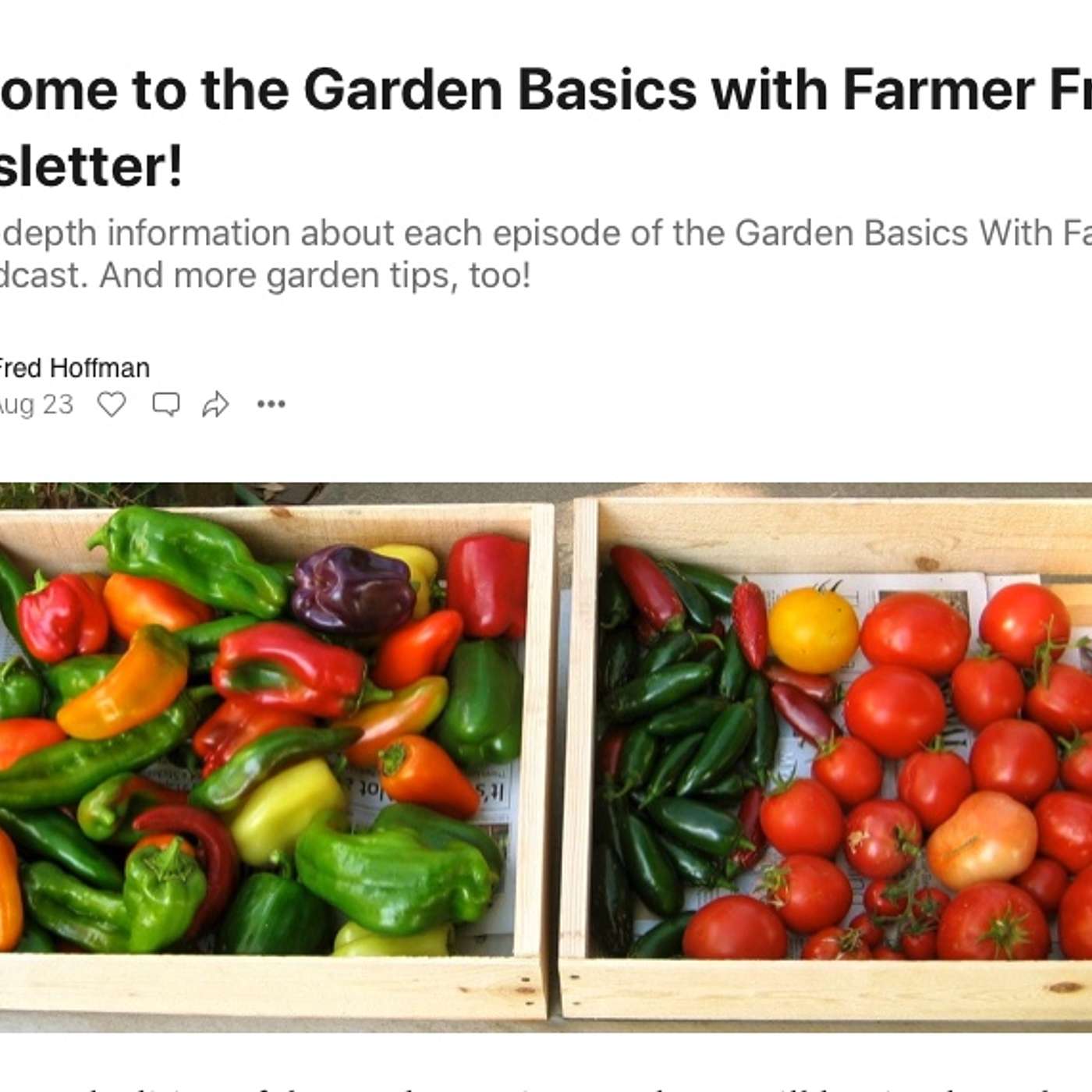
Garden Basics with Farmer Fred
Tips for beginning and experienced gardeners. New episodes arrive every Friday. Fred Hoffman has been a U.C. Certified Master Gardener since 1982 and writes a weekly garden column for the Lodi News-Sentinel in Lodi, CA. A four-decade fixture in Sacramento radio, he hosted three radio shows for Northern California gardeners and farmers: The KFBK Garden Show, Get Growing with Farmer Fred, and the KSTE Farm Hour. Episode Website: https://gardenbasics.net
Garden Basics with Farmer Fred
143 Wind vs. Your Garden. The Goldenrod.
If you have a lot of leaning trees and shrubs on your property, chances are there’s an ill wind blowing around your home. Our favorite retired college horticulture professor, Debbie Flower, has some ideas on helping your plants survive, even thrive, is areas with persistent winds.
UC Davis Arboretum Superintendent Emeritus, Warren Roberts, tells us about a popular, fall-blooming Plant of the Week, the Goldenrod, also known as Solidago. And as you will find out, it’s nothing to sneeze at. It’s on episode 143 of the Garden Basics with Farmer Fred podcast, brought to you today by Smart Pots and Dave Wilson Nursery.
And we will do it all in under 30 minutes. Let’s go!
(Pictured: the Plant of the Week, Goldenrod, aka Solidago californica)
Pictured:
Goldenrod, Solidago californica
Links:
Smart Pots
Dave Wilson Nursery
UC Davis Arboretum
The Garden Basics with Farmer Fred Newsletter
A wind break for small spaces
Goldenrod Seeds (Solidago)
More episodes and info available at Garden Basics with Farmer Fred
Garden Basics comes out every Tuesday and Friday. Live links, product information, transcripts, and chapters available at the Buzzsprout home site for Garden Basics with Farmer Fred.
Got a garden question?
• Leave an audio question without making a phone call via Speakpipe, at https://www.speakpipe.com/gardenbasics
• Call or text us the question: 916-292-8964.
• E-mail: fred@farmerfred.com
All About Farmer Fred:
The Garden Basics with Farmer Fred Newsletter
Farmer Fred website: http://farmerfred.com
Daily Garden tips and snark on Twitter
The Farmer Fred Rant! Blog
Facebook: "Get Growing with Farmer Fred"
Instagram: farmerfredhoffman
Farmer Fred Garden Videos on YouTube
Subscribe to the free, Garden Basics with Farmer Fred Newsletter
As an Amazon Associate, I earn from qualifying purchases from possible links mentioned here.
And thank you for listening.
Thank you for listening, subscribing and commenting on the Garden Basics with Farmer Fred podcast and the Beyond the Garden Basics Newsletter.
Farmer Fred 0:00
Garden Basics with Farmer Fred is brought to you by Smart Pots, the original lightweight, long lasting fabric plant container. it's made in the USA. Visit SmartPots.com slash Fred for more information and a special discount, that's SmartPots.com/Fred. Welcome to the Garden Basics with Farmer Fred podcast. If you're just a beginning gardener or you want good gardening information, you've come to the right spot.
Farmer Fred 0:33
If you have a lot of leaning trees and shrubs on your property, chances are there's an ill wind blowing around your home. Our favorite retired college horticulture Professor, Debbie Flower, has some ideas on helping your plants survive, even thrive, in areas with persistent winds. UC Davis Arboretum Superintendent Emeritus Warren Roberts tells us about a popular fall blooming plant of the week. It's the goldenrod, also known as solidago. And as you will find out, it's nothing to sneeze at. It's on episode 143 of the Garden Basics with Farmer Fred podcast, brought to you today by Smart Pots and Dave Wilson Nursery. And we'll do it all in under 30 minutes. Let's go.
Farmer Fred 1:18
We like to answer your garden questions here on the Garden Basics podcast. Debbie Flower is here, our favorite retired college horticultural professor, and we get a question from San Louis Obispo County on the Pacific Ocean in the middle of the state. It's a beautiful area. Here's Lisa with a question:
Lisa from Arroyo Grande 1:40
This is Lisa, from Arroyo Grande, California, I live three miles from the ocean. Any tree I plant has a terrible leeward bend? Any suggestions? Thank you, and I love your show.
Farmer Fred 1:54
Thank you for calling, Lisa. And she called us at 916-292-8964, 916-292-8964. You too can call and leave a low quality audio question with us to answer or for high audio quality, go on your computer or your smartphone to speakpipe.com/gardenbasics. speakpipe.com/gardenbasics and then all you have to do is yell at the phone. And the question will get here in real high audio quality. So let's tackle Lisa's question there. Yeah, when you live near the coast where there are persistent winds and it also could be in many places across the country, inland as well. You know what farmers have been doing for years and years and years is building windbreaks.
Debbie Flower 2:40
Right one term we might need to define for landlubbers is "looward" or leeward and that is...
Farmer Fred 2:46
oh you must have lived near the coast.
Debbie Flower 2:48
I did live near the coast, yes. My father was a shellfish farmer for a while then he became a professor. but anyway "looward" is to the to the safe side for a boat. You want to get out of the wind. it's away from the wind and so it's toward the land from from the coast and that's because the wind is coming off the coast, persistently hitting this plant and it's causing it to bend toward the land.
Farmer Fred 3:19
I'm real confused now. I always thought if you had your face in the wind you're facing windward.
Debbie Flower 3:26
Yes, facing the wind. Yeah, so her trees were bending away from the wind, to the "looward" side.
Farmer Fred 3:32
Okay, bending to the looward side.
Debbie Flower 3:33
Yes, Yes, looward.
Farmer Fred 3:35
I will never say leeward again.
Debbie Flower 3:37
Yes. Well, live around guys who are on boats all day. That's what they say. And you're absolutely right, a windbreak is the thing to do. And I lived in Reno, it's a very, very windy place because it's right on the east side of the Sierra Nevada. And the the winds come, the cold air comes up the California side, the air goes up the California side, it cools off at the top of the hills. And then it comes zooming down on the Reno side. And it was so windy that I used to joke that one day the wind stopped and I fell over because I'd been walking at an angle all the time.
Farmer Fred 4:11
Well, that's interesting, because I once did a really stupid bike ride that went from Lake Tahoe to Baker, Utah along Highway 50. And so that's a west to east. And every afternoon while doing that, there would just be heinous winds out of the South,
Debbie Flower 4:31
Out of the South?
Farmer Fred 4:32
Out of the South. Yeah. And then pick up in the afternoons and you're saying in Reno, which is not that far north of highway 50, that the winds were coming out of the West. Mm hmm. Okay.
Debbie Flower 4:40
This was so bad. My kids were young and the playgrounds had sand in them and they just got sandblasted. It was horrible. But anyway, they had a display actually, when they finally put together a display garden in the Wilbur Mays Arboretum. They had a display by a local landscape architect of windbreaks, because there were so many problems with winds and gardens in Nevada, so the windbreak is the solution, a row of tall plants, poplars, Lombardy poplars, are often used. To create a windbreak something tall and narrow. The Casuarina (mountain she-oak) I have could be used for that. In the garden they made, they did manmade ones with posts and wove rubber, actually strips, through it. The big thing to understand about a windbreak is you're not building a wall, you're not trying to stop the wind, though, if you build a solid wall, the wind will hit it and it will go up the wall, pick up speed, come over the other side, it'll miss a section right close to the fence. But when it comes down on the other side, it will come down even harder. So you're just revving the wind up by building a wall that it will hit. You want to build something that has spaces between it. So a row of trees with spaces between it or or some sort of posts, fencing, but has to have spaces between it.
Farmer Fred 6:06
When I lived in the country, we were battered every winter by the winds out of the southeast to the point where truly that side of the house was sandblasted, and water would seep in the patio door and through the windows. And I started doing a lot of research about windbreaks. And there are plenty of eucalyptus trees in that area of Sacramento County, out in the country. And I started planting Eucalyptus seed but I planted three different varieties about 200 feet, 150 feet away from the house. The first row was the eucalyptus leucoxylon, which tops out at about 30 feet. And those trees were spaced in a row, running perpendicular to that corner where the winter wind would hit. And those trees were spaced eight feet apart. The next row up, moving closer to the house, about 20 feet up the hill from that, I planted another variety of eucalyptus (camuldensis) that got about 40 feet tall. So that's it. It went from a 20 foot row to a 40 foot row. Then the third row I planted was Eucalyptus globulus, the blue gum tree, which gets 50 to 60 feet long. So what you ended up with if you're looking at the tops of the trees, it would look like the design of an airplane wing. And an airplane wing is designed to add lift to get the wind off the top
Debbie Flower 7:40
Yeah, and to raise whatever it is.
Farmer Fred 7:43
And it turns out it works that if you have three rows like that, whatever the tallest row is, it's going to protect up to seven times that height away from it, away from the wind. So with those 50 foot Eucalyptu,s along with those two other rows, it raised the wind up to 50 feet times seven, 350 feet it protected. So that house was protected.
Debbie Flower 8:10
So if Lisa has a lot of property,
Farmer Fred 8:12
she could. But probably not.
Debbie Flower 8:16
They would have to be salt tolerant plants because she's right near the coast. But she could build a windbreak out of different heights of shrubbery but they too will be battered by the wind and so she'll probably never get anything as tall as 50 feet but she will get a protected area on that far side of it, the inland side of it.
Farmer Fred 8:37
My guess being in Arroyo Grande, it's very expensive real estate and they're very small lots, huh? So let's delve into some reality. And maybe just go with evergreen shrubs.
Debbie Flower 8:53
They're gonna bend as well. They will Yes. If you go to the coast and look at evergreen trees, let's say conifers pines, they are all sort of low and and why because they're they're beat by the wind all the time. So if she had some sort of posts if you have to be very tough, she can get a lot of telephone poles and then...
Farmer Fred 9:18
Your neighbors love will love it, Lisa!
Debbie Flower 9:22
Weave the rubber between them and leave spaces between the rubber and that will stop the wind. Or, A bamboo fence that's very tall and very securely attached to posts. It's going to be tough,
Farmer Fred 9:37
and probably the CC&R's wouldn't allow it, if it is probably more than eight feet tall.
Debbie Flower 9:41
Probably yes. Yes. It's gonna be tough move, Lisa.
Farmer Fred 9:44
Yeah, go inland do something.
Debbie Flower 9:47
I wonder about a shade sail that's on an angle. This is producing the wall and it's reproducing the structure you're talking about that you made with the eucalyptus, where it's low at the one end and goes up high. That would take the wind up over the top. You'd have to really secure that shade sail.
Farmer Fred 10:05
Okay, well 'splain this one to me, Lucy. When I was growing the pin oaks and the Scarlet oaks and there was a persistent wind the rest of the year from the west, the Delta winds from the west. And in their early stages of life these pin oaks and Scarlet oaks had a definite bend eastward. Mm hmm. I forget who told me, they said don't worry about it, they'll straighten themselves out. They did.
Debbie Flower 10:28
Did they straighten themselves out or the other thing a tree will do is on that bent part. Again, it has to do with hormones. We were talking about auxins before. It has to do with a collection of hormones, and at that spot will generate a new leader from that spot.
Farmer Fred 10:42
Possibly, yeah, yeah. And why would that one be straight?
Debbie Flower 10:46
Well, you said the wind changed that much in the winter.
Farmer Fred 10:50
The worst was coming out of the southeast. But that was only during the winter. In spring, summer and fall, the persistent afternoon wind was out of the West, and it was really windy. Okay. And yes, those young trees did have a bend to them to the east. But in time, I didn't see it.
Debbie Flower 11:09
It can be continuous. Here's another bypass. Okay, I started mesquite tree from seed. We did it at school, and somebody who worked in and caring for the plants, the tree was maybe a foot tall. The person topped it, bad thing to do to a tree. And so it didn't develop as a leader. It just had all these floppy branches. And so I stacked up a branch, and it bent over at the top and then another branch formed, and it bent over at the top and another branch formed and it bent over it. So it just was a continuous addition of a new at that bent spot, it got a new branch, which then would get to a certain height and not fall over itself. And then at that spot on the second branch, it would bend over and it would throw a branch and then the third branch would throw a branch and I now have a mesquite tree that I can walk under that has a relatively straight trunk from all of those new branches growing together as a single trunk. So plants can be pretty amazing.
Farmer Fred 12:13
But in that whole thing I did not hear you say, "so top your trees."
Debbie Flower 12:17
No, no, topping trees is the wrong thing to do. Judicious pruning. If you do see something that's starting to go up straight, you can remove some of the side growth so that it becomes the leader. You can choose the leader.
Farmer Fred 12:33
I just thought of an answer for Lisa. This will work and Lisa you'll make money from it. Around here, especially in the more rural areas. When the cell phone people are putting up towers, they will bow to local demand and disguise the towers. And some of these towers look like ugly Christmas trees. But you know at first glance, "oh, that's a weird looking tree", but you think it's a tree from a distance. So Lisa, you could contract with Verizon and AT&T and T-mobile and all those companies, to build cell towers in your backyard and disguise them as a tree.
Debbie Flower 13:13
There you go. And then you've got a windbreak, a metal tree,
Farmer Fred 13:16
And your neighbors would kick you out. But you'd have great reception.
Debbie Flower 13:21
So ultimately, yes, it's I don't think we have a good answer for Lisa. There are things to try, but it's she's working against a very strong force of nature.
Farmer Fred 13:30
Move, or grow something shorter, shorter than your fence. Right? bonsai.
Debbie Flower 13:39
That's really short. Yes.
Farmer Fred 13:40
Well, we tried Lisa, thanks for your question. We'll move on, Debbie Flower Thanks for your help on this.
Debbie Flower 13:46
Always fun to do this, Fred. Thank you.
Farmer Fred 13:54
We're glad to have Smart Pots on board, supporting the Garden Basics podcast. Smart Pots. It's the original, award-winning fabric planter. It's sold worldwide. And Smart Pots are proudly made, 100% in the USA. Smart Pots come in a wide array of sizes and colors. If a frost or freeze is in the forecast, moving your frost tender plants that are in the Smart Pots that have handles makes them easier to move closer to the house for added warmth. Or, you could even move them inside for the winter. Visit SmartPots.com slash Fred for more information about the complete line of Smart Pots lightweight, colorful fabric containers. And don't forget that slash Fred part. Because on that page, are details of discounts when you buy Smart Pots at Amazon. If you want to see them before you buy Smart Pots they are available at independent garden centers and select Ace and True Value hardware stores nationwide. To find a store near you visit Smart Pots.com slash Fred.
Farmer Fred 14:56
If you're thinking of growing fruit trees, or maybe you already have your own backyard full of fruit trees, you probably have a million questions. Like, which fruit trees will grow well where I live? What are the tastiest fruits to grow? How do I care for them? What are the most important things to know when starting a backyard orchard? Well, the good news is: those answers are just a click away with the informative videos that you can find at DaveWilson.com. That's Dave Wilson Nursery, the nation's largest grower of fruit trees for the backyard garden. At DaveWilson.com , you'll also find planting tips, taste test results, fruit variety recommendations, and links to nurseries in your area that carry Dave Wilson fruit trees. Your harvest to better health begins at DaveWilson.com.
Farmer Fred 15:52
Every week we like to talk with Warren Roberts. He is the superintendent emeritus of the UC Davis Arboretum and public garden. He always has an interesting plant of the week for us, something that might be putting on a show right now where you live. And today's plant is one that is widely available and widely grown. It's nothing to sneeze at. It's goldenrod.
Warren Roberts 16:18
Goldenrod. But let's take your phrase, "nothing to sneeze at". As a matter of fact, contrary to popular opinions, the goldenrod does not cause hayfever.
Farmer Fred 16:30
Are they paying you to say that?
Warren Roberts 16:35
No. I don't have any investment in it. No that is printed on most information that you find out about about Solidago. However, many of them are used as medicines. So it's not so much causing trouble. It's helping to cure difficulties and health difficulties. We won't go into that today. But people can look that up on the web. Solidago, goldenrod. Medicinal uses. Now as is often the case, the scientific name is subject to science. So if new changes are found, then the nomenclature sometimes shifts. Luckily for solidago, most of the cultivated ones that we have our solidago, but there are some of the ones in cultivation are now called Euphamia. Some are called Bigelowia, they're about five more, mainly native to the southeast US, and actually on into the western United States down to Mexico, or there are some species or genera just found in the deserts. But solidago is the main generic name to use. Now there are different forms of solidago. Some are groundcovers, some are tall, they do tend to move around in the garden a little bit, but they're useful. Now solidago can come in any color that you want, as long as it's yellow. Now there are some hybrids between goldenrod and Michaelmas Daisy, they're called soladaster. And they pretty much look like goldenrods to the ones I've seen, anyway. The ones that are ground covers, or that is to say low growing, have, I think, a very nice usefulness in the garden. And they really only need once a year care. After the flowers have faded, the plants start to look a little ratty, then just cut them back to the ground and they'll come back for you. They can also be propagated easily by division. So it is a pretty useful genus for the garden. Some get really tall at four feet or so. And then some are low growing. So you have your choice with this useful genus of flowering plants. And they produce a lot of color this time of year. So a good fall blooming plant
Farmer Fred 19:09
And they're not very particular about the soil they're in are they?
Warren Roberts 19:13
No, they're not. They pretty much like what most any plant likes: well drained soil, but you can have them growing in clay or loam, or even rocks. So they're pretty, pretty useful. I remember one garden in Sparks, Nevada. That was really a big rock and the goldenrods did fine there. They do need a little water in summer to thrive. Even the California native does better if you water it a little bit in the summer.
Farmer Fred 19:49
Full sun or light shade, the solidago, the goldenrod, does quite well. Many of the latest hybrids too are very recommended. with names like "Crown of Rays", "Golden Baby", "Goldenmosa" and 'Little Lemon", all of which get maybe two feet high. So that's a nice selection you might find at your local nursery. The Goldenrod. The plant of the week, courtesy of Warren Roberts from the UC Davis Arboretum and public garden. Their website is Arboretum.ucdavis.edu. Pay a visit, check out all the plants that they have there in the Arboretum at UC Davis. And you can read about the plant sales that they have coming up in October as well. If you happen to be in Northern California, you might want to check that out, the goldenrod. Warren Roberts, thanks so much for making me put the Claritin away.
Warren Roberts 20:41
You're welcome Fred.
Farmer Fred 20:52
Because there are so many demands on your time these days, I like to keep the Garden Basics podcast to under 30 minutes. Still, there is a lot more to tackle on all the garden subjects we bring up on the podcast. So, for that, and a lot more, we’re starting up The Garden Basics with Farmer Fred newsletter, on Substack. As the newsletter grows, so will the subject matter. So, yes, it will be a good supplement for the Garden Basics podcast, but there will be a lot more garden related material and probably pictures of my dogs and cats, as well. It’s the Garden Basics with Farmer Fred Newsletter on Substack. And best of all, it’s free! There’s a link in today’s show notes. Or, just go to substack.com, and do a search for Garden Basics with Farmer Fred. That’s substack.com. The Garden Basics with Farmer Fred newsletter. Did I tell you it’s free? It’s free.
Farmer Fred 21:55
Garden Basics comes out every Tuesday and Friday. It's brought to you by Smart Pots. Garden Basics is available wherever podcasts are handed out. And that includes Apple, Iheart, Stitcher, Spotify, Overcast, Google, Podcast Addict, Cast Box, and Pocket Casts. Thank you for listening, subscribing and leaving comments. We appreciate it.




